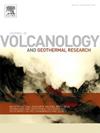Tracking changes in the tremor sources associated with a Gorely Volcano degassing episode in 2013
IF 2.3
3区 地球科学
Q2 GEOSCIENCES, MULTIDISCIPLINARY
Journal of Volcanology and Geothermal Research
Pub Date : 2025-09-20
DOI:10.1016/j.jvolgeores.2025.108452
引用次数: 0
Abstract
Gorely, one of the most active volcanoes in Kamchatka, experienced a long period of degassing from 2010 to 2013. This degassing has been accompanied by intense seismovolcanic activity in form of nearly continuous tremors that were recorded by a temporary network of seismographs. To better understand the relationship between the volcanic degassing and seismic signals, we analyze here three months of continuous seismic data of 15 stations operated in 2013 using the network covariance matrix approach. We identified a high-coherence seismovolcanic tremor in the 0.5–5 Hz frequency band and examined its temporal variations by analyzing the spectral width of the covariance matrix. Tremor sources were located and clustered based on the first eigenvectors of the covariance matrix. We identified three sequential tremor source clusters active throughout the observation period. Most of tremor sources were located beneath Gorely within the volcanic edifice, above 1 km depth. A small group of sources located at depths up to 3 km below sea level is aligned along a nearly vertical conduit-like structure. When the seismic activity switched from cluster 1 to cluster 3 in mid-October 2013, the tremor sources were slightly shifted toward northeast. During the period of cluster 1 (before October 15, 2013) the peaks of low tremor coherence coincided with the precipitation. Based on the frequency distribution of high-coherence signals, source locations and volcanological observations, we suggest that the tremor activity is controlled by complex gas dynamics within the volcano and its interaction with infiltrating meteoric fluids in Gorely's conduit system.
追踪与2013年戈里火山脱气事件相关的震源变化
戈里火山是堪察加半岛最活跃的火山之一,从2010年到2013年经历了长时间的脱气。这种脱气伴随着强烈的地震火山活动,以几乎连续的震动的形式出现,这些震动被一个临时的地震仪网络记录下来。为了更好地理解火山脱气与地震信号之间的关系,本文采用网络协方差矩阵方法对2013年运行的15个台站连续3个月的地震数据进行分析。我们在0.5-5 Hz频段确定了一个高相干地震-火山震颤,并通过分析协方差矩阵的谱宽来研究其时间变化。根据协方差矩阵的第一特征向量对震源进行定位和聚类。在整个观测期间,我们确定了三个连续的地震震源群。大多数震源位于戈雷里火山大厦下方,深度在1公里以上。位于海平面以下3公里深处的一小群震源沿着几乎垂直的导管状结构排列。2013年10月中旬,当地震活动从1群切换到3群时,震源向东北方向轻微移动。在第1簇期间(2013年10月15日之前),低相干性峰值与降水一致。根据高相干信号的频率分布、震源位置和火山学观测,我们认为此次地震活动受火山内部复杂的气体动力学及其与Gorely管道系统中渗透的大气流体的相互作用控制。
本文章由计算机程序翻译,如有差异,请以英文原文为准。
求助全文
约1分钟内获得全文
求助全文
来源期刊
CiteScore
5.90
自引率
13.80%
发文量
183
审稿时长
19.7 weeks
期刊介绍:
An international research journal with focus on volcanic and geothermal processes and their impact on the environment and society.
Submission of papers covering the following aspects of volcanology and geothermal research are encouraged:
(1) Geological aspects of volcanic systems: volcano stratigraphy, structure and tectonic influence; eruptive history; evolution of volcanic landforms; eruption style and progress; dispersal patterns of lava and ash; analysis of real-time eruption observations.
(2) Geochemical and petrological aspects of volcanic rocks: magma genesis and evolution; crystallization; volatile compositions, solubility, and degassing; volcanic petrography and textural analysis.
(3) Hydrology, geochemistry and measurement of volcanic and hydrothermal fluids: volcanic gas emissions; fumaroles and springs; crater lakes; hydrothermal mineralization.
(4) Geophysical aspects of volcanic systems: physical properties of volcanic rocks and magmas; heat flow studies; volcano seismology, geodesy and remote sensing.
(5) Computational modeling and experimental simulation of magmatic and hydrothermal processes: eruption dynamics; magma transport and storage; plume dynamics and ash dispersal; lava flow dynamics; hydrothermal fluid flow; thermodynamics of aqueous fluids and melts.
(6) Volcano hazard and risk research: hazard zonation methodology, development of forecasting tools; assessment techniques for vulnerability and impact.

 求助内容:
求助内容: 应助结果提醒方式:
应助结果提醒方式:


